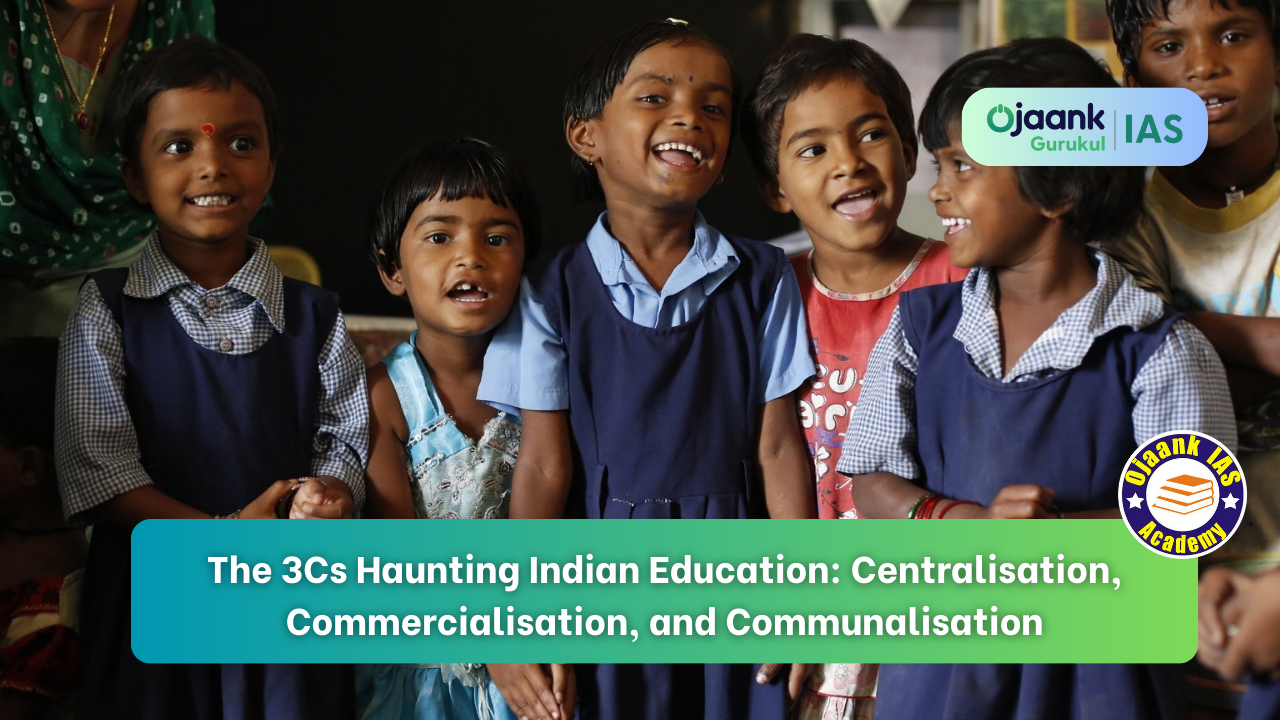The 3Cs Haunting Indian Education: Centralisation, Commercialisation, and Communalisation

India’s education system today stands at a dangerous crossroads—its foundation destabilised by a systematic trifecta of policy missteps: centralisation, commercialisation, and communalisation. While the government projects the National Education Policy (NEP) 2020 as a transformational leap, a closer inspection reveals that the policy is a façade masking an agenda that is undermining the constitutional promise of equal, quality education for all.
1. Centralisation: The Erosion of Federalism in Education
Over the past decade, the Union Government has orchestrated an aggressive centralisation of power, drastically sidelining State governments and dismantling cooperative federalism in education.
-
The Central Advisory Board of Education—India’s apex education policy body involving both Union and State Education Ministers—has not convened since 2019.
-
Key education decisions under NEP 2020 were rolled out without meaningful consultation with State governments.
-
PM-SHRI schools are being forced upon States by withholding rightful grants under the Samagra Shiksha Abhiyan, using funds meant for the implementation of the Right to Education (RTE) Act as leverage.
The most alarming shift has occurred in higher education governance. The draft UGC guidelines of 2025 strip States of their authority in appointing Vice-Chancellors, giving disproportionate control to Union-appointed Governors. This shift is not just unconstitutional—it’s a full-frontal attack on India’s federal structure.
Read more about how centralisation is weakening federalism in India’s education system.
2. Commercialisation: A Backdoor Privatisation of Public Education
The second C—commercialisation—has led to the dismantling of the public education system and the flourishing of expensive, under-regulated private institutions.
-
Since 2014, 89,441 public schools have been shut down, while 42,944 private schools have mushroomed across the country.
-
The NEP’s promotion of school complexes effectively reverses the RTE’s neighborhood school guarantee, pushing students from marginalised backgrounds further away from educational access.
-
In higher education, the Higher Education Financing Agency (HEFA) has replaced direct government grants with market-rate loans. Universities are being forced to recover these loans via massive student fee hikes—an indirect but cruel taxation on the youth.
This rampant commercialisation is also breeding corruption: from the NAAC bribery scandal to the NTA’s constant mismanagement, the accountability of public institutions is collapsing under pressure from privatised interests.
3. Communalisation: The Ideological Hijack of Education
The final and most insidious C is communalisation—the ideological distortion of history, social science, and institutional culture to align with a sectarian narrative.
-
NCERT textbooks have been scrubbed clean of inconvenient truths: Gandhi’s assassination and Mughal India chapters have been erased, and even the Preamble of the Indian Constitution was briefly removed.
-
Professorships and leadership positions in premier institutions like IITs and IIMs are increasingly reserved for individuals aligned with regime ideologies, often with little academic merit.
-
The UGC is actively diluting the qualification criteria for professors and Vice-Chancellors, prioritising ideological loyalty over educational excellence.
This manipulation of curriculum and institutions is not just about rewriting history—it’s about indoctrinating the future of India.
Read more about the rise of privatisation and its consequences on public education in India.
A System in Peril: Students Are Paying the Price
What connects these three Cs is a clear departure from the spirit of public service, constitutional morality, and academic freedom. The victims are the students—forced to navigate a broken system that neither educates nor empowers.
The NEP 2020, far from being a visionary reform, is a blueprint for systemic regression, centralising control, commodifying access, and communalising content.
As Sonia Gandhi, Member of Parliament (Rajya Sabha) and Chairperson of the Congress Parliamentary Party, rightly points out:
“Over the last decade, our education systems have been systematically cleansed of the spirit of public service, and education policy has been sanitised of any concerns about access and quality.”
India’s education crisis is not just a policy issue—it’s a moral and constitutional emergency. The future of millions of young Indians depends on dismantling this 3C strategy and returning to a vision rooted in equity, inclusivity, and scientific temper.
Final Thoughts: It's Time to Reclaim Education
This is not a partisan issue—it’s about the soul of our democracy. Education must empower, not indoctrinate. It must include, not exclude. It must enlighten, not commercialise. The longer we allow this silent carnage to continue, the deeper the scars on India's future.
Let us rise, question, and demand an education system that lives up to the spirit of our Constitution and the dreams of our children.
Get the latest insights on India’s education reforms and their long-term impact.
If this post struck a chord, share it. Let’s make education a public movement again. #SaveEducation #Stop3Cs #IndianEducationReform
//////////////////////////////